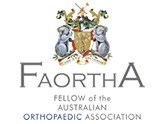
Patellofemoral Knee Replacement
Arthritis is a general term covering numerous conditions where the joint surface or cartilage wears out. The joint surface is covered by a smooth articular surface that allows pain free movement in the joint. This surface can wear out for a number of reasons; often the definite cause is not known.
When the articular cartilage wears out the bone ends rub on one another and cause pain. This condition is referred to as Osteoarthritis or “wear and tear” arthritis as it occurs with aging and use. It is the most common type of arthritis.
When arthritis affects the knee joint, it commonly occurs in two compartments, usually the medial and patellofemoral compartment. It is not common for a patient to have arthritis isolated to the patellofemoral compartment, but it does occur and is more commonly seen in women. Patellofemoral arthritis is diagnosed when the arthritic damage is only located in the patellofemoral compartment, affecting the back of the knee cap.
Causes of Arthritis
There are numerous conditions that can cause arthritis but often the exact cause is never known. In general, but not always, it affects people as they get older (Osteoarthritis).
Other causes include:
- Trauma (fracture)
- Increased stress such as overuse and overweight
- Infection of the bone
- Connective tissue disorders
- Inactive lifestyle and Obesity (overweight); Your weight is the single most important link between diet and arthritis as being overweight puts an additional burden on your hips, knees, ankles and feet.
- Inflammation (Rheumatoid arthritis)
Symptoms
Patellofemoral Arthritis or knee cap arthritis causes pain and decreased mobility that is usually localized to the front of the knee joint. The patellofemoral compartment is involved in activities such as walking up and down hills or stairs, kneeling or squatting and standing back up. These activities can be become almost impossible to do when the pain from the arthritic damage is severe enough. Patients with this type of arthritis usually have no pain when walking on flat surfaces even when walking long distances.
Diagnosis
Evaluating the source of knee pain is critical in determining your treatment options for relief of the pain. Knee pain should be evaluated by an Orthopaedic specialist for proper diagnosis and treatment.
Your physician will perform the following:
- Medical History
- Physical Examination
Depending on what the history and exam reveal, your doctor may order medical tests to determine the cause of your knee pain and to rule out other conditions.
Diagnostic Studies may include:
- X-rays: X-rays are a form of electromagnetic radiation that is used to take pictures of bones. An X-ray can reveal if osteoarthritis from degenerative changes is causing your knee pain.
The diagnosis of osteoarthritis is made on history, physical examination & X-rays. There is no blood test to diagnose Osteoarthritis (wear & tear arthritis).
Conservative Treatment Options
Conservative treatment options refer to management of the problem without surgery.
Some conservative treatment measures for knee osteoarthritis include:
- Activity Modification and Limitations
- Weight Reduction
- Anti-inflammatory Medications
- Physical Therapy
- Orthotics such as canes, braces, or insoles
- Injection of steroid and analgesic into the knee joint
Patellofemoral Knee Replacement surgery may be recommended by your surgeon if you have osteoarthritis contained to the patellofemoral compartment and you have not obtained adequate relief with conservative treatment options.
Traditionally, a patient with only one compartment of knee arthritis would undergo a Total Knee Replacement surgery. Patellofemoral Knee Replacement is a minimally invasive surgical option that preserves the knee parts not damaged by arthritis as well as the stabilizing anterior and posterior cruciate ligaments, ACL and PCL. This less invasive bone and ligament preserving surgery is especially useful for younger, more active patients as the implant placed more closely mimics actual knee mechanics than does a total knee surgery.
The smaller implants used with a partial knee replacement surgery are customized to the patient’s anatomy based upon CT scans of the patient’s knee. A surgical Robotic Arm assists the surgeon with preoperative planning and intraoperative component placement, positioning, and alignment. Patellofemoral Knee Arthroplasty surgery will not alter the ability of the patient to eventually move to a Total Knee Replacement in the future should that become necessary.
Partial Knee Replacement surgery is performed in an operating room under sterile conditions with the patient under general anaesthesia or spinal anaesthesia with sedation. It is usually performed on an outpatient basis as day surgery.
- The surgeon makes a small incision, about 3-4 inches long over the knee.
- With the assistance of the robotic arm, the patellofemoral compartment is prepared for the artificial components by removing the damaged part of the patella and trochlea, the groove at the end of the femur.
- The new artificial components are fixed in place with the use of bone cement.
- The femoral component is made of polished metal and the patellar component looks like a plastic button which will glide smoothly in a groove located on the femoral component.
- With the new components in place, the knee is taken through a range of movements.
- Once the surgeon is satisfied with the results, the arthroscope and surgical instruments are removed and the incisions covered with a sterile dressing or biologic glue.
Post-Operative Recovery
Common Post Operative guidelines include:
- You will be taken to the recovery room and monitored for any complications.
- You will be given pain medication to keep you comfortable at home.
- You will need someone to drive you home due to the drowsy effects of the anaesthesia.
- Swelling is normal after knee surgery. Ice, compression, and elevation of the knee will be used to minimize swelling and pain.
- You will be given specific instructions regarding activity. Usually there are few activity restrictions.
- You will be referred to a rehabilitation program for exercise and strengthening.
- Eating a healthy diet and not smoking will promote healing.
Risks and Complications
Specific Complications related to Patellofemoral Knee Replacement surgery include:
- Infection: Infection can occur with any operation. In the knee this can be superficial or deep. Infection rates are approximately 1%. If it occurs it can be treated with antibiotics but may require further surgery.
- Deep Vein Thrombosis: DVT are blood clots that can form in the calf muscles and travel to the lung (Pulmonary embolism). These can occasionally be serious and even life threatening. If you get calf pain or shortness of breath at any stage, you should notify your surgeon.
- Ligament injuries: There are a number of ligaments surrounding the knee. These ligaments can be torn during surgery or break or stretch out any time afterwards. Surgery may be required to correct this problem.
- Injury to blood vessels or nerves: Also rare but can lead to weakness and loss of sensation in part of the leg. Damage to blood vessels may require further surgery if bleeding is ongoing.
- Arthrofibrosis: This is the development of thick, fibrous material around the joint that often occurs after joint injury or surgery and can lead to joint stiffness and decreased movement.
- Wear: The components eventually wear out over time, usually 10 to 15 years, and may need to be changed.
- Dislocation: An extremely rare condition where the ends of the knee joint lose contact with each other.
- Fractures or breaks: Can occur during surgery or afterwards if you fall. To fix these, you may require surgery.












